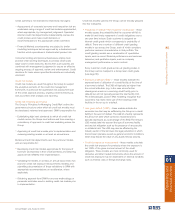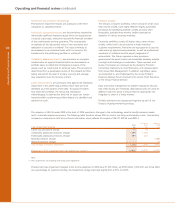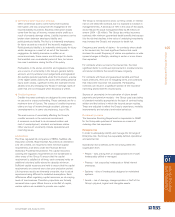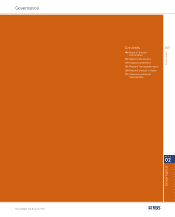RBS 2005 Annual Report Download - page 101
Download and view the complete annual report
Please find page 101 of the 2005 RBS annual report below. You can navigate through the pages in the report by either clicking on the pages listed below, or by using the keyword search tool below to find specific information within the annual report.
section
01
Operating and
financial review
99
Operating and financial review
Annual Report and Accounts 2005
The Group also provides liquidity back-up facilities to both its
own conduits and certain other conduits which take funding
from the US$ commercial paper market. Limits sanctioned for
such facilities totalled less than £11 billion at 31 December
2005. The short-term contingent liquidity risk in providing such
back-up facilities is also mitigated by the spread of maturity
dates of the commercial paper taken by the conduits.
The Group has operated within its non-sterling liquidity policy
mismatch limits at all times during 2005 and operational
processes are actively managed to ensure that is the case
going forward.
Developments in liquidity risk management regulation
Following the Basel Committee’s publication of Sound
Practices for Managing Liquidity in Banking Organisations in
February 2000, a number of regulatory bodies internationally
began reviewing their regulatory liquidity frameworks.
In the UK, the FSA published a discussion document – DP24 –
in October 2003 setting out draft proposals for a new
quantitative framework to operate in the UK. Comments made
to the FSA, by the Group and other banks collectively, in
response to these proposals, made clear the desirability of an
internationally coordinated approach to the regulation of
liquidity. An international forum of regulators, chaired jointly by
the FSA and the US Federal Reserve Bank, was also
established in 2004 to review regulation across the OECD.
Their report is awaited. In 2005, the European Commission has
also begun to consider the subject.
Following earlier consultation, the FSA also introduced in
January 2005, new requirements for liquidity management
systems and controls, particularly in respect of stress testing,
contingency funding plans and related documentation. The
Group has complied with these requirements and will continue
to do so going forward.
The Group has been, and continues to be, actively involved in
working with the various regulatory bodies to assist the
development of an appropriate future regulatory liquidity
regime which takes into account local national considerations
but also gives due recognition to the integrated cross-border
approach to the management of liquidity risk within most
international banking groups.
Taking account of the indicative future regulatory requirements
published to date, the Group continues to develop its liquidity
risk reporting, management and stress testing capabilities.
Market risk
The Group is exposed to market risk because of positions held
in its trading portfolios and its non-trading business including
the Group’s treasury operations. The Group manages the
market risk in its trading and treasury portfolios through its
market risk management framework, which is based on value-
at-risk (“VaR”) limits, together with, but not limited to, stress
testing, scenario analysis, and position and sensitivity limits.
Stress testing measures the impact of abnormal changes in
market rates and prices on the fair value of the Group’s trading
portfolios. GEMC approves the high-level VaR and stress limits
for the Group. The Group Market Risk function, independent
from the Group’s trading businesses, is responsible for setting
and monitoring the adequacy and effectiveness of the Group’s
market risk management processes.
Value-at-risk
VaR is a technique that produces estimates of the potential
negative change in the market value of a portfolio over a
specified time horizon at given confidence levels. For internal
risk management purposes, the Group’s VaR assumes a time
horizon of one day and a confidence level of 95%. The Group
uses historical simulation models in computing VaR. This
approach, in common with many other VaR models, assumes
that risk factor changes observed in the past are a good
estimate of those likely to occur in the future and is, therefore,
limited by the relevance of the historical data used. The
Group’s method, however, does not make any assumption
about the nature or type of underlying loss distribution.
The Group typically uses the previous two years of market
data. The Group’s VaR should be interpreted in light of the
limitations of the methodology used. These limitations include:
•Historical data may not provide the best estimate of the joint
distribution of risk factor changes in the future and may fail
to capture the risk of possible extreme adverse market
movements which have not occurred in the historical window
used in the calculations.
•VaR using a one-day time horizon does not fully capture the
market risk of positions that cannot be liquidated or hedged
within one day.
•VaR using a 95% confidence level does not reflect the extent
of potential losses beyond that percentile.
The Group largely computes the VaR of trading portfolios at
the close of business and positions may change substantially
during the course of the trading day. Controls are in place to
limit the Group’s intra-day exposure; such as the calculation of
the VaR for selected portfolios. These limitations and the nature
of the VaR measure mean that the Group cannot guarantee
that losses will not exceed the VaR amounts indicated.
Trading
The principal focus of the Group’s trading activities is client
facilitation – providing products to the Group’s client base at
competitive prices. The Group also undertakes: market making
– quoting firm bid (buy) and offer (sell) prices with the intention
of profiting from the spread between the quotes; arbitrage –
entering into offsetting positions in different but closely related
markets in order to profit from market imperfections; and
proprietary activity – taking positions in financial instruments as
principal in order to take advantage of anticipated market
conditions. The main risk factors are interest rates, credit
spreads and foreign exchange. Financial instruments held in
the Group’s trading portfolios include, but are not limited to,
debt securities, loans, deposits, securities sale and repurchase
agreements and derivative financial instruments (futures,
forwards, swaps and options). For a discussion of the Group’s
accounting policies for, and information with respect to, its
exposures to derivative financial instruments, see Accounting
policies and Note 19 on the accounts.
























